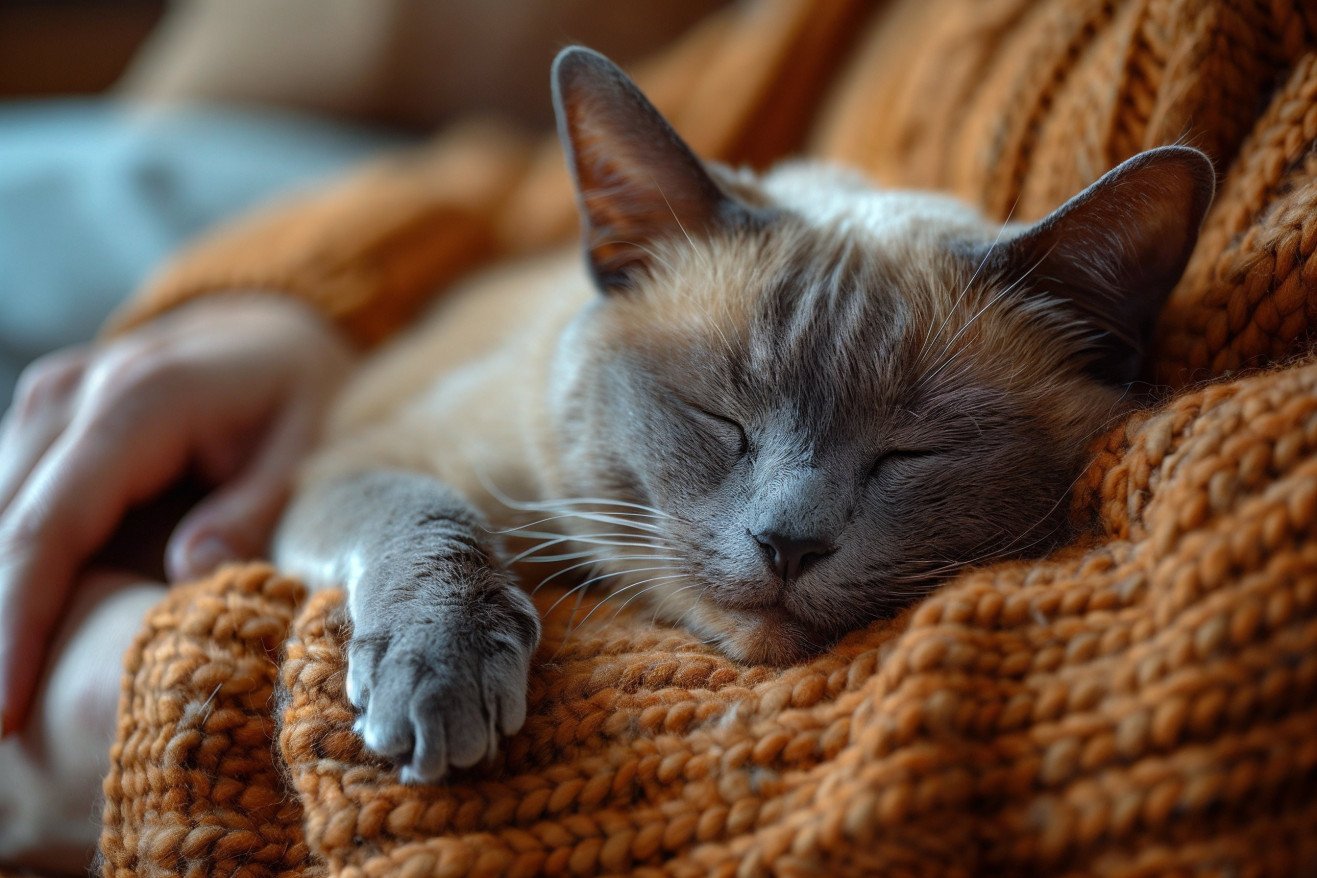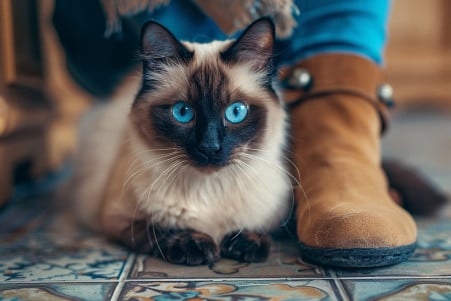Why Does My Cat Love Me So Much? The Science of Feline Attachment
16 April 2024 • Updated 15 April 2024

If you’ve ever experienced your cat trailing you from room to room, constantly seeking your attention and affection, you may have found yourself asking why cats can become so attached to their owners. Cats form strong attachments to their human caregivers for several reasons, including their social nature as a species that lives in colonies, their association of you with food and safety, and their tendency to seek out warm places to sleep, among other factors.
While a cat’s attachment to their person may be sweet, learning more about the reasons behind it can help you better understand your cat’s needs and even their evolutionary history. In this article, we’ll review the latest findings from researchers in the fields of feline behavior, evolutionary biology, and animal psychology to help you better understand the many reasons that cats form deep bonds with their human companions. By learning about the special relationship between people and their pet cats, you’ll come away with a deeper understanding of how to nurture this important connection.
Why is my cat obsessed with me?
Why Do Cats Knead? Theories and Explanations
Kneading, which is sometimes called "making biscuits," is an instinctive behavior that cats carry with them from kittenhood. According to Purina UK, kittens knead their mother's belly to stimulate milk flow from her teats. This helps them get the nutrition they need to grow and develop. The kneading motion, along with the release of the bonding hormone oxytocin, also helps the mother and her kittens form a closer relationship.
As cats grow, they continue to knead as a way to show that they're feeling comfortable and to help themselves relax, especially if they're feeling stressed or anxious. The repetitive motion and the association with nursing also releases chemicals in the brain that make cats feel good, such as dopamine. When cats knead a soft surface, such as their human's lap, it's also a way to show trust and affection and to help them form a closer bond with their human that's similar to the bond they share with their mother.
In addition, the behavior may also be a holdover from wild cats that pawed at foliage to make a comfortable, safe place to rest, and to check for predators. When cats knead their human, they're also claiming them as part of their social group. In addition, cats can leave their scent from glands in their paw pads, which helps them mark their territory.
In addition, female cats may knead more when they're in heat, and the behavior may be a way to let male cats know that they're ready to mate. While kneading is a normal behavior, excessive compulsive kneading may be a sign of an underlying medical condition that requires veterinary care. However, in most cases, this odd feline behavior is simply a way for your cat to show you how safe, secure, and loved they feel in your presence.
Understanding Cat Body Language: How Cats Show Affection and Attachment
Cats have a number of ways to show their affection and attachment through body language. For example, Oprah Daily notes that cats often treat their owners like other cats, which can manifest in behaviors like rubbing on them, following them, and sleeping near them. Meanwhile, showing their belly is a sign of trust because it's a vulnerable position. Cats also use their tails to communicate, and an upright tail that's slightly curved is a sign that a cat is happy to see their owner.
Vocalizations like purring are one of the most obvious ways cats express their contentment and attachment, according to Purina UK. Cats can also give their owners "eye kisses" by slowly blinking at them, which is a way of showing that they feel safe and secure with them. Mutual grooming, which is when cats lick their owners, is another way that cats mix their scent with their owners' and mark them as part of their social group, according to Catster.
Other ways cats show their attachment include bringing their owners "gifts" of prey and controlling their owners during playtime, according to The Spruce Pets. Learning about these different ways that cats communicate can help people better understand how their pets show their love and trust, even if they can't talk to us.
Why Do Cats Stare at Their Owners? What Your Cat's Intense Gaze Means
Cats may stare at their owners as a way to communicate and get rewards, like food or attention. According to the Cats Protection Blog, this curious behavior can actually be something the owner has trained the cat to do without realizing it. If the cat has stared at the owner in the past and received a treat or attention, the cat will learn to associate eye contact with a positive outcome and continue the behavior.
Staring can also indicate a close bond between a cat and their owner, as cats are unlikely to hold eye contact with someone they don't trust. Purina UK explains that a slow blink while staring shows even greater trust and affection, the feline equivalent of an "eye kiss." However, a cat's stare can convey various emotions, from curiosity and boredom to hunger or a desire for interaction.
Understanding a cat's body language and the context of the stare is crucial to interpreting its meaning. As PetHelpful notes, dilated pupils can indicate fear, aggression, surprise or excitement, while constricted pupils usually mean a cat feels relaxed. Paying attention to these subtle cues can help owners better understand their cat's motivations behind their intense stare.
How to Strengthen Your Relationship With Your Cat: Advice for Building a Stronger Bond
Building a strong relationship with your cat involves setting up an environment that meets their needs and preferences. As Modkat notes, this can include comfortable places to rest, stimulating toys, and other essentials that will help your cat feel safe and secure.
In addition, regular playtime is important, since, according to CNN, cats are social animals who need interaction with their human caregivers. Playing with your cat in ways that mimic their natural hunting and exploring behaviors can help strengthen your bond. That said, it's also important to let your cat have their space and not force them to interact if they don't want to.
Finally, positive reinforcement, such as giving your cat a treat or a pet when they knead, head-butt, or slow blink at you, can help you build a stronger bond with your cat. As WebMD notes, these behaviors are all signs that your cat feels comfortable and safe with you, and rewarding them can help you build a stronger relationship with your cat.
In the end, building a strong relationship with your cat takes time and effort. But by setting up a supportive environment, making time for play, respecting your cat's boundaries, and using positive reinforcement, you can build a relationship with your cat that's both meaningful and fulfilling.
Conclusion: Understanding the Special Relationship Between Cats and Their Owners
Cats love their people, even if they don’t always show it in the most obvious ways. Cats form strong attachments to their owners and their emotional expressions are remarkably similar to those of humans. Cats can show their love through understanding and concern for others, and have been known to risk their lives for their owners. Cats can also detect when their owner is upset and will often console them or lick away their tears. Some cases exist where an owner left or passed away, and the cat exhibited signs of distress like sitting and meowing at the owner's bedroom door, going into hiding, even refusing to eat.
A study published in the journal Current Biology found that cats see their owners as more than just a source of food; they are also a source of security and comfort, too. The research found that around 64% of the cats were secure in their attachment, trusting that their owner would look after their needs. This debunked the myths that cats are solely standoffish, emotionally distant, and unable to bond with their humans.
Cats are more independent in that we don't have to train them to use the litter box the same way we have to housebreak a puppy. But that doesn't necessarily mean they don't use us as a source of security and that they aren't affectionate towards people. According to research from the Human-Animal Interaction Lab at Oregon State University, the majority of cats do use their owners as a source of security and rely on them for comfort. In fact, 50% of cats prefer human interactions over their favorite food, scent items, and toys.
By understanding and embracing the ways cats express their love and trust, you can deepen the connection between you and your feline friend. And accepting a cat’s obsession with their owner is a testament to the special and enduring relationship between these two species.


